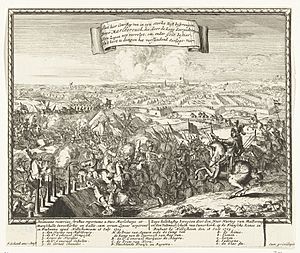Battle of Elixheim facts for kids
Quick facts for kids Battle of Elixheim |
|||||||
|---|---|---|---|---|---|---|---|
| Part of the War of the Spanish Succession | |||||||
 |
|||||||
|
|||||||
| Belligerents | |||||||
| Grand Alliance: |
|||||||
| Commanders and leaders | |||||||
| Strength | |||||||
| 14,000 (initially) | 3,000–15,000 | ||||||
| Casualties and losses | |||||||
| 50–200 | 3,000 | ||||||
The Battle of Elixheim, 18 July 1705, also known as the Passage of the Lines of Brabant was a battle of the War of the Spanish Succession. The Duke of Marlborough successfully broke through the French Lines of Brabant, an arc of defensive fieldworks stretching in a seventy-mile arc from Antwerp to Namur. Although he was unable to bring about a decisive battle, the breaking and subsequent razing of the lines would prove critical to the allied victory at Ramillies the next year.
Prelude
Early in the campaigning season, Marlborough attempted to launch an invasion of France up the Moselle valley. This effort was halted by a combination of supply shortages and an excellent French defensive position in front of Sierck, and Marlborough and his army were recalled by the Dutch States General when Marshall Villeroi attacked and took the fortress of Huy and threatened Liège. Having rushed back to the Low Countries (and forcing Villeroi to retreat behind his defenses), Marlborough retook Huy, and then planned to break through the lines to bring Villeroi to battle.
On the eve of the Battle of Elixheim, 17 July 1705, Dutch troops, consisting of 22 battalions and 30 squadrons, under Noyelles and Hompesch attacked the castle of Wangen that protected a bridge across the Gete river and a part of the Lines of Brabant. In two columns, the Dutch marched forward. Both columns were preceded by a detachment of grenadiers. The attack on the castle itself was to be carried out by the left column, at a stone bridge over the Geete, close to the village of Nederhespen. Sixty experienced grenadiers were ordered to take control of the Geete crossing point. They then had to break through the French lines through a flank attack and wait for reinforcements. The cavalry of the right column had the task of routing the enemy dragoons at Orsmael. 16 June at 9 pm, the advance had begun. However, due to various complications, it would take until 4am the next day for the first troops to arrive at the river. Nevertheless, the attack went smoothly. Poor reconnaissance by the French meant that the French had been unaware of the Dutch advance. The castle, occupied by 30 French soldiers, was quickly taken and the French lines also offered little resistance. Noyelles' right-wing column broke through the lines at Over- and Nederhespen without a fight.
Breakthrough
On the evening of 17 July Marlborough sent the Dutch troops under Marshal Overkirk in a feint southward towards Namur, drawing Villeroi and 40,000 men after them. Overnight he marched with his own English and Scottish troops northwards to the small village of Eliksem (Elixheim) were he joined the Dutch troops under Noyelles. After a cavalry battle in which Marlborough personally participated, the Allies managed to disperse the French squadrons with heavy losses. The Dutch cavalry under Hompesch then captured the French artillery. With support from the infantry that had been deployed, the French cavalry tried to recover, but a second charge overwhelmed them for good. Only the discipline of the French infantry under Caraman managed to prevent the French force from being annihilated. In square, harassed and threatened on all sides by the Allied cavalry, they held firm and made a successful retreat. The Allies however were able to break through the lines. Realising this, Villeroi withdrew his army to the west, behind the river Dyle.
Aftermath
Unable to pursue the French with any vigour on the day of the battle due to the exhaustion of his men, who had marched all night and then fought an intense battle, Marlborough nonetheless still hoped to bring Villeroi to battle. Dutch general Slangenburg, 'hero of Ekeren', argued that the Allies should advance to Leuven. Leuven was necessary to secure the logistics of the Allied army if they wanted to capture Brussels and would perhaps have forced Villars fight. Marlborough felt something for his plan, but told Slangeburg to convince Nassau-Ouwerkerk and Daniël van Dopff, who were against this plan of action. Slangenburg was, however, unable to convince them. Dopff argued that the troops would be too tired and that it would be difficult to construct bridges across the Gete in time.
Marlborough did not challenge the opinions of Ouwerkerk and Dopff and, instead of advancing on Leuven, made a circumferential move west of the lines with 80,000 troops to cut Villeroy off from Brussels. As a result, he ran into logistical problems. A month of frustrating manoeuvring followed. A final effort in early August, using waggons loaded with supplies to remove his dependency on his lines of communication, forced Villeroi's army to make a stand close to Waterloo. In desperation, Marborough ordered to attack the French in their strong positions at the Dyle, but this was vetoed by the Dutch generals, most notably Slangenburg. The Dutch generals refused to approve the attack, because they believed that the 70,000 numbering French army was to well entrenched. Marlborough thereupon accused Slangenburg of obstruction after which the Dutchman expressed doubts about his suitability to serve as supreme commander. Disagreements between the allied generals ran so high that a political crisis between the Dutch Republic and England threatened. Willem Buys managed to calm tempers by promising Marlborough that Slangenburg would be suspended - formally for health reasons. However, Marlborough's demand that the field deputies also be sent home was dismissed.
The Duke had to content himself with the capture of the fortress of Leau and the levelling of the Lines of Brabant between Leau and the Meuse.

